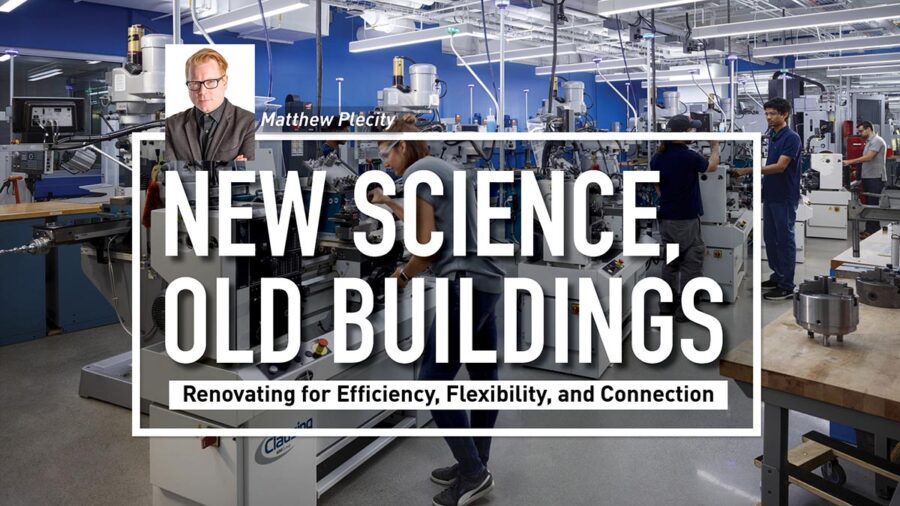Insights
Jan 17, 2024 _ insights
New Science, Old Buildings: Renovating for Efficiency, Flexibility, and Connection
What does the research space of the future look like? And can it be housed in older buildings (or does it require new construction)?
In a previous article (here), I laid out a series of concerns that need to be considered when designing for the future of higher education research spaces. On the one hand, I described the close relationship between scientific research and the space in which it takes place, establishing the need for those spaces to evolve to keep up with changing research methods and agendas. This established the need for updated research spaces (if not new ones altogether). On the other hand, I described the difficult financial situation in which many colleges and universities find themselves. Overbuilt and underfunded, they face a growing backlog of deferred maintenance costs and an impending decline in enrollment.
In short, while acknowledging the need to invest in research facilities, I also suggested the wisdom of considering renovations rather than defaulting to new construction. Smart renovations of existing spaces can do a lot to increase their efficiency and productivity while turning them into spaces that boost collaboration and attract talent.
Effective renovations of research spaces offer an opportunity to:
1. Recalibrate existing lab space, increasing efficiency and productivity.
Though I described the accelerating changes in how labs work (from technological changes to the expectation that they provide a healthier, more supportive environment), the fact is that labs have been changing for a long time.
Academic labs, in particular, tend to grow through a long process of accretion. They often slowly expand into empty adjacent spaces or add new instruments wherever they happen to fit. So, rather than fitting new machines into the workflow of an existing space, researchers often end up working around the new machine (wherever it lands). In my experience, researchers are quite inventive in figuring out how to adapt their space to accommodate additional equipment, but that doesn’t necessarily produce the optimal environment for research discoveries.

A large-scale renovation of a research building offers a good chance to reset. Unlike those small decisions, where furniture and equipment are added here and there, comprehensive renovations allow the design team and user groups to re-envision lab processes, creating more ideal workflows.
Our renovation of Hammerschlag Hall to create a new home for TechSpark—Carnegie Mellon University’s (CMU) largest makerspace—offers a good illustration of this. The century-old building had undergone a patchwork of additions and renovations, resulting in a space that was frequently disorienting and cramped. While expanding makerspaces and machine shops, our renovation created a more open and intuitive floor plan that gave researchers the room they needed to work efficiently, comfortably, and safely. In fact, a study of the renovated space, published in The Journal of the Minerals, Metals & Materials Society reported that, “the rate of research output has increased dramatically” and “the facility is being used extensively for hands-on, graduate-level instruction.”
2. Prioritize flexibility, build in adaptability.
With the current pace of innovation, flexibility is more critical than ever. By way of illustration, we recently designed an additives lab for CMU at Mill 19—a state of the art, off-campus facility housed within the remains of a former steel mill—and we had to update the equipment order several times before the lab was even built. It wasn’t a long project, but the pace of technological change is just that quick!
This is characteristic of the changes that are affecting research across the board. From the ever-expanding capacity of rapid prototyping equipment to increasingly networked and automated research processes, the infrastructure of research is quickly changing. This makes it essential that renovations take pains to create a space that can accommodate changes in the way we work.
 Thus, we find ourselves designing for flexibility. Whether we’re designing labs for rotating research teams in new buildings like University of Cincinnati’s (UC) Digital Futures or renovating spaces in the 1200 Wing of CMU’s Hammerschlag Hall, we are not building a lot of highly specialized equipment into lab space. Instead, we’re using adaptable, modular design elements and features, like regularly-spaced, drop-down power lines to enable researchers to easily reconfigure their space as their needs change.
Thus, we find ourselves designing for flexibility. Whether we’re designing labs for rotating research teams in new buildings like University of Cincinnati’s (UC) Digital Futures or renovating spaces in the 1200 Wing of CMU’s Hammerschlag Hall, we are not building a lot of highly specialized equipment into lab space. Instead, we’re using adaptable, modular design elements and features, like regularly-spaced, drop-down power lines to enable researchers to easily reconfigure their space as their needs change.
3. Reconfigure research spaces for connectivity.
Historically, the design of research buildings contributed to the tendency of the sciences to become siloed. From the early 20th Century to the Brutalist designs of the 1950s and 1960s, these buildings were designed to usher researchers to their labs. It was assumed researchers would go directly to their bench and stay put. There was little connection between spaces, few interior windows, and few opportunities to share (or even glimpse what others were working on). As interdisciplinary research has gained more currency—and socialization and relaxation have become understood as valuable, not just to humans but also to the research process—there is increasing demand for research buildings to foster connection.
These are table stakes in new research spaces. Thus, our design of UC’s Digital Futures building uses glass-lined lab spaces, research galleries, and shared resources (makerspaces, meeting rooms, VR Labs, and social spaces) to encourage conversation between researchers. And our study of CMU’s Science Futures Building called for the inclusion of science-adjacent programs, like an art gallery and colocation with the School of Computer Science, to encourage connection.
But opportunities to enrich research through social connection can also be created in existing buildings. In our renovation of the 8000-level of CMU’s Wean Hall, for instance, we’re blowing out windowless, concrete block walls and replacing them with glass partitions. This not only creates spaces that flow into one another, but it is transforming a wing where nothing was visible into a place to see and be seen. Shared breakout spaces complement this effort, helping researchers to connect.
As automated processes, AI, and the scientific internet of things transform lab work, enabling increased hybrid work arrangements, shared spaces outside the lab will become more important for socializing and working while enjoying easy access to the lab.
 Matthew Plecity, AIA, ASLA is a principal at GBBN. An architect with a landscape architecture background, Matt leverages his understanding of site and context to design buildings with strong relationships to their environments. As part of the leadership team for GBBN’s Higher Education Market, he regularly shares his insights into campus design, sustainability, academic libraries, and research spaces at regional, national, and international conferences. Matt loves collaborating with clients, colleagues, and consultants to build bold ideas like University of Pittsburgh’s Hillman Library renovation and Penn State Behrend’s Federal House.
Matthew Plecity, AIA, ASLA is a principal at GBBN. An architect with a landscape architecture background, Matt leverages his understanding of site and context to design buildings with strong relationships to their environments. As part of the leadership team for GBBN’s Higher Education Market, he regularly shares his insights into campus design, sustainability, academic libraries, and research spaces at regional, national, and international conferences. Matt loves collaborating with clients, colleagues, and consultants to build bold ideas like University of Pittsburgh’s Hillman Library renovation and Penn State Behrend’s Federal House.




